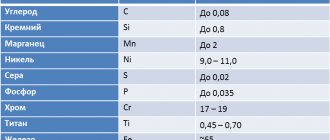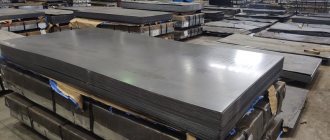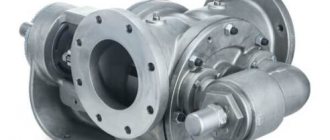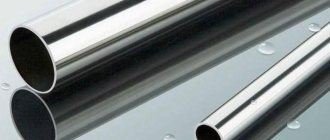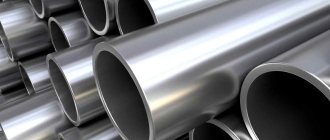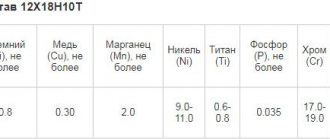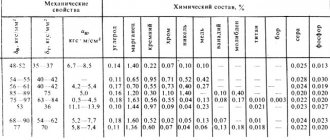AISI 304 steel has an almost full-fledged analogue - alloy grade 12Х18Н10Т. However, some differences in the chemical composition of these alloys make it possible to compare them and find the difference between aisi 304 and 12x18n10t in the properties when using them. So, when choosing steel for the manufacture of a certain type of structure or part, you must be guided by this data.
Chemical composition that allows you to determine the difference between aisi 304 and 12x18n10t
Nickel. AISI 304 – up to 10-11%. 12Х18Н10Т - similar
Chromium. AISI 304 - up to 20%. 12Х18Н10Т — 17-19%
Copper. AISI 304 – up to 0.3%. 12Х18Н10Т - similar
Carbon – AISI 304 – up to 0.08%. 12Х18Н10Т – up to 0.12%
Titanium - AISI 304 - no more than 0.3%. 12Х18Н10Т – 0.8%.
For the complete chemical composition of these alloys, see table.
| Stamps | C | Mn | P | S | Si | Cr | Ni | Ti | Fe |
| 12Х18Н10Т | <0,12 | <2,0 | <0,035 | <0,02 | <0,8 | 17,0-19,0 | 9,0-11,0 | <0,4-1 | Rest |
| AISI 304 | <0,08 | <2,0 | <0,045 | <0,03 | <1,0 | 18,0-20,0 | 8,0-10,5 | — | Rest |
Stainless steel 12x18n10t and analogue AISI 304 12x18n10t - comparison of steels.
AISI 304 steel has an almost full-fledged analogue - alloy grade 12Х18Н10Т. However, some differences in the chemical composition of these alloys make it possible to compare them and find the difference between aisi 304 and 12x18n10t in the properties when using them. So, when choosing steel for the manufacture of a certain type of structure or part, you must be guided by this data.
Perm, Kultaevo
stainless steel welding
Chemical composition that allows you to determine the difference between aisi 304 and 12x18n10t
Nickel. AISI 304 – up to 10-11%. 12Х18Н10Т – similar
Chromium. AISI 304 – up to 20%. 12Х18Н10Т – 17-19%
Copper. AISI 304 – up to 0.3%. 12Х18Н10Т – similar
Carbon – AISI 304 – up to 0.08%. 12Х18Н10Т – up to 0.12%
Titanium – AISI 304 – no more than 0.3%. 12Х18Н10Т – 0.8%.
Marking of stainless steels GOST
| steel grade | Characteristic | Chemical composition, % |
| 06ХН28МДТ (analogue: AISI 904L) | Stainless steel is used for the manufacture of welded chemical equipment operating at temperatures up to 80 degrees in highly aggressive environments. | Ni 26-29; Cr 22-25; Cu 2.5-3.5; Mo 2.5-3; Si ≤0.8; Mn ≤0.8; Ti 0.5-0.9; C ≤0.06; P ≤0.035; S ≤0.02; Fe rest. |
| 08Х17Н13М2Т (analogue: AISI 316Ti) | Stainless steel of this grade is characterized by high ductility, is easily molded and does not have magnetic properties. | C up to 0.08; Si up to 0.8; Mn up to 2; Ni 12-14; S up to 0.02; P up to 0.035; Cr 16-18; Mo 2-3; Cu up to 0.3; (5 C-0.7) Ti ; Fe ≈61 |
| 08Х18Н9 | Austenitic stainless steel with high chromium content. It is used in the production of steel seams, fittings, and heat exchange equipment. | Cr 17-19; Ni 8-10; C 0.8; Si 0.8; Ti 0.5; Cu 0.3; Mn 0.2; P 0.035; S 0.02 |
| 08Х18Н10 (analogue: AISI 304) | This stainless steel is characterized by increased strength, ductility and resistance to ultra-high temperatures. The alloy has no magnetic properties. | Cr 17-19; Ni 9-11; C 0.8; Si 0.8; Ti 0.5; Cu 0.3; Mn 0.2; P 0.035; S 0.02 |
| 08Х18Н10Т (analogue: AISI 321) | Characterized by high heat resistance. There are no magnetic properties. It is used for the manufacture of folds, heat exchange equipment, and parts of furnace fittings. | Cr 17-19; Ni 9-11; Mn up to 2; Si up to 0.8; Ti 0.4-0.7; Cu up to 0.3; S up to 0.2; C up to 0.08; P up to 0.035; Fe ≈69 |
| 08Х22Н6Т | Belongs to the austenitic-ferritic group of alloys. Does not lose its properties even when used in an aggressive environment. | Cr 21-23; Si up to 0.8; Mn up to 0.8; Ni up to 0.8; Cu up to 0.3; C up to 0.08; P up to 0.035; S up to 0.025; (5 C - 0.65) Ti ; the rest is Fe |
| 10Х17Н13М2Т (analogue: AISI 316Ti) | Stainless steel retains its physical properties and characteristics even at high temperatures (up to 600 degrees). | Cr 16-18; Ni 12-14; Mo 2-3; Mn no more than 2; Si no more than 0.8; Ti 0.5-0.7; Cu not more than 0.3; P not more than 0.035; S no more than 0.02 |
| 10Х18Н10Т | Heat-resistant stainless steel is used for the manufacture of parts for welded equipment operating in aggressive environments. Suitable for the production of furnace equipment, heat exchangers and pipes. | Cr 17-19; Ni 10-11; Mn 1-2; Si up to 0.8; C up to 0.1; P up to 0.035; S up to 0.02; 5(C - 0.02) < Ti < 0.6 |
| 10Х23Н18 (analogue: AISI 310S) | High-alloy, high-temperature resistant stainless steel belongs to the austenitic group of alloys. | Cr 22-25; Ni 17-20; Mn up to 2; Si up to 1; Cu 0.035; Ti 0.3; C up to 0.1; S up to 0.02; P up to 0.02 |
| 12Х18Н9 (analogues: AISI 301, 302, 303, S30200) | Belongs to the group of austenitic alloys. It is used in the manufacture of parts that subsequently undergo a hardening stage: parts of furnace fittings, heat exchangers, rotors, couplings. | Cr 17-19; Ni 8-10; Mn ≤ 2; Si ≤ 0.8; Ti ≤0.5; Mo ≤0.5; Cu ≤0.3; C ≤ 0.12; P ≤0.035; S ≤0.02; Fe about 70 |
| 12Х18Н10Т (analogues: AISI 321, 321H) | Austenitic grade stainless steel. It is used in the food, pharmaceutical and chemical industries, petrochemical industry, mechanical engineering, and energy. | Cr 17-19; Ni 9-11; Mn no more than 2; Si no more than 0.8; Ti 0.6-0.8; Cu not more than 0.3; P not more than 0.035; S no more than 0.02 |
| 12Х18Н12Т | High-alloy steel is used in the manufacture of parts operating at elevated temperatures. Use in aggressive environments is allowed. | Cr 17-19; Ni 11 - 13; Mn up to 2; Si up to 0.8; Cu up to 0.3; C up to 0.12; P up to 0.035; S up to 0.02; (5 C - 0.7) Ti ; the rest is Fe |
| 14Х17Н2 (analogue: AISI 431) | Belongs to the martensitic-ferritic group of alloys. This stainless steel is difficult to weld and is prone to temper brittleness. | Cr 16-18; Ni 1.5-2.5; Si 0.8; Mn 0.8; Cu 0.3; C 0.11-0.17; P 0.03; Ti 0.2 |
| 20Х23Н18 (analogue: AISI 310) | High-alloy heat-resistant steel. Used for the production of individual combustion chambers, clamps, suspensions, and fastening parts. Seamless pipes are also made from steel of this grade, which will be used at high temperatures. | Cr 22-25; Ni 17-20; Mn no more than 2; Si no more than 1; Cu not more than 0.3; Ti no more than 0.2; P not more than 0.035; S no more than 0.02 |
| 08Х13 (analogues: AISI 403, 409, 410S, 429) | Belongs to the group of ferritic alloys. Steel has good corrosion resistance and can withstand high temperatures. | Cr 12-14; Si 0.8; Mn 0.8; Ni 0.6; C 0.08; P 0.03; S 0.025 |
| 08Х17 (analogue: AISI 430) | Characterized by a high chromium content. Used in mechanical engineering, food and chemical industries. | Cr 16-18; Si 0.8; Mn 0.8; Ni 0.6; C 0.08; P 0.03; S 0.025 |
| 12Х13 (analogue: AISI 410) | Brittle steel that is difficult to weld. Belongs to the martensitic-ferritic class. | Cr 12-14; Si 0.8; Mn 0.8; Ni 0.6; C 0.1; P 0.03; S 0.025 |
| 12Х17 (analogue: AISI 430) | Belongs to the ferritic group. Does not lose its properties, even when exposed to acids and salt solutions. | Cr 16-18; Si 0.8; Mn 0.8; C 0.12; P 0.035; S 0.025 |
| 20Х13 (analogue: AISI 420) | It belongs to the martensitic class of alloys and is intended for the manufacture of power engineering parts, furnace equipment, various fasteners and fittings. This stainless steel is difficult to weld and is prone to temper brittleness. | Cr 12-14; Si 0.6; Mn 0.6; Ni 0.6; C 0.2; P 0.033; S 0.025 |
| 30Х13 (analogues: AISI 420S, 420F) | This steel is not suitable for welding. It is used for the manufacture of springs, compressor parts and other devices. | Cr 12-14; Si 0.8; Mn 0.8; Ni 0.6; C 0.3; Cu 0.3; Ti 0.2; P 0.03; S 0.025 |
| 40Х13 (analogue: AISI 420) | Stainless steel made from this alloy is distinguished by its high level of wear resistance and heat resistance. It is used for the manufacture of cutting and measuring tools, as well as compressor parts that operate at high temperatures. | Cr 12-14; Si 0.6; Mn 0.6; C 0.4; P 0.03; S 0.025 |
The full chemical composition of 12Х18Н10Т and AISI 304 is in the table.
| Stamps | C | Mn | P | S | Si | Cr | Ni | Ti | Fe |
| 12Х18Н10Т | <0,12 | <2,0 | <0,035 | <0,02 | <0,8 | 17,0-19,0 | 9,0-11,0 | <0,4-1 | Rest |
| AISI 304 | <0,08 | <2,0 | <0,045 | <0,03 | <1,0 | 18,0-20,0 | 8,0-10,5 | – | Rest |
AISI 316, AISI 316T, AISI 316L
AISI 316 steel
Steel grade 316 is an austenitic nickel-containing steel. The domestic analogue of this brand is 08x17n13m2. 316 steel is high strength, corrosion resistant, ductile and heat resistant. The advantages of steel include the addition of molybdenum and a higher content of chromium and nickel. 316 steel is considered an improved version of AISI 304 stainless steel. It does not have magnetic properties. AISI 316 steel is quite easy to process, form and weld.
Application of steel:
Mechanical engineering and construction
Chemical, food and other industries
For the manufacture of products exposed to high temperatures, mechanical stress and oxidizing environments.
Other
Steel AISI 316 L
AISI 316 L is a corrosion-resistant austenitic steel. Due to the low carbon content of this grade, it is better suited for the manufacture of welded structures. Domestic analogues of AISI 316L steel are grades 03x17n14m3 and 04x17n13m2. This grade of steel is used to produce various equipment for the food, chemical, mining, oil refining and paper and pulp industries.
AISI 316 Ti steel
AISI 316Ti is an austenitic stainless steel with a lower carbon content. This steel is obtained by adding titanium to the base grade AISI 316. Titanium increases resistance to aggressive environments. 316 Ti steel is used for the production of equipment in mechanical engineering, as well as for the production of equipment in other industries. Domestic analogues of grade 316 Ti are grades 03Х17Н14М3, 10Х17Н13М2Т and 10Х17Н13М3Т.
The steel is easy to weld. No heat treatment is required after welding. Welds must be chemically or mechanically descaled and then passivated
AISI 316/316L easily finds many applications, being extremely elastic, durable and ductile. Common operations include bending, drawing, contouring, rotary drawing, etc. The forming process can use the same tools and machines that are used for carbon steel. This is due to the greater degree of hardening during forming of austenitic steel.
The annealing temperature range is 1050°C ± 25°C followed by air or water cooling. After annealing, etching and passivation are required.
Tempering occurs at temperatures from 200 to 400°C, followed by cooling in air.
Chemical composition (% by weight)
| Brand | WITH | Ni | Mo | Si | Mn | Cr | P | S |
| AISI 316 | ≤ 0.08 | 10-14 | 2.00-3.00 | ≤ 0.75 | ≤ 2.0 | 16-18 | ≤ 0.045 | ≤ 0.03 |
| AISI 316L | ≤0.03 | 10-14 | 2.00-3.00 | ≤ 0.75 | ≤ 2.0 | 16-18 | ≤ 0.045 | ≤ 0.03 |
| AISI 316Ti | ≤0.080 | 10-14 | 2.00-2.50 | ≤0.75 | ≤2.0 | 16-18 | ≤ 0.045 | ≤ 0.03 |
Mechanical Properties (room temperature)
| Rp m Ultimate strength (tensile), N/mm2 | elongation (% in L = 5.65 S0) | Organoleptic Eriksen test, mm | Fatigue strength, N/mm2 | Brinell hardness - HB | Rp0.2 Elasticity limit (yield), (0.2%), N/mm2 | ||
| AISI 316 | Type | 580 | 55 | 8-10 | 260 | 165 | 310 |
| Min | 515 | 40 | — | — | — | 205 | |
| AISI 316L | Type | 570 | 60 | 10-11 | 260 | 165 | 300 |
| Min | 485 | 40 | — | — | — | 170 | |
| AISI 316 Ti | Type | 600 | 50 | — | 260 | 165 | 320 |
| Min | 515 | 40 | — | — | — | 205 |
Physical properties (AISI 316L)
| Physical properties | Density | Melting temperature | Specific heat | Thermal expansion | Average coefficient of thermal expansion | Electrical resistivity | Magnetic permeability | Elastic modulus |
| Unit | — | °C | J/kg.K | W/mK | 10-6.K-1 | Ωmm2/m | at 0.80 kA/m | MPa x 103 |
| Temperature (°C) | 4 | 20 | 20 | 20-100 20-300 20-500 | 20 | 20 | 20 | |
| Meaning | 8,0 | 1440 | 500 | 15 | 16,0 17,0 18,0 | 0,75 | 1,005 | 200 |
AISI 316 product range
Standard sizes of AISI 409 stainless steel sheet
| steel grade | Domestic substitute | Material type | Surface | Thickness, mm | Width, mm |
| Aisi 316, Aisi 316L, AISI 316T | 08x17n13m2t 03x17n13m2t 10x17n13m2t | cold rolled | 2B | 0,4-3,0 | 1000x2000 1250x2500 1500x3000 |
| hot rolled | 1D | 2-100 | 1000x2000 1250x2500 1500x3000 1500x6000 |
Standard sizes of AISI 316 stainless steel pipes
| Hot deformed | Cold-worked |
| The products meet the requirements of GOST 9940-81 Hot-deformed seamless pipes made of corrosion-resistant material. Outer diameter: 6mm -406.4mm Wall thickness: 1mm - 4mm | The products meet the requirements of GOST 9941-81 Cold- and heat-deformed seamless pipes made of corrosion-resistant material. Outer diameter: 6 mm -406.4 mm Wall thickness: 1 mm - 4 mm |
Where can I buy?
Website creation: Media7.ru
Properties of stainless steels – aisi 304 and 12x18n10t.
Similar properties of stainless alloys aisi 304 and 12x18n10t allow us to consider them interchangeable in the manufacture of various structures.
Stainless steel 12x18n10t has the advantage of higher ductility and toughness after hardening; it also has its disadvantages compared to aisi 304. The hardness and strength of steel 12x18n10t is lower than that of steel 304, due to the higher chromium content.
The similarity of chemical compositions gives experts the right to believe that the Russian-made 12x18n10t stainless alloy is a close analogue of imported AISI 304 steel.
Features of stainless steel production
At steel foundries, when choosing the chemical composition of a corrosion-resistant alloy, they are guided by the rule that if a metal that forms a solid solution with it and is resistant to corrosion (for example, chromium) is added to a metal that is unstable to corrosion (for example, chromium), then a protective effect appears jumpwise with the introduction of 1/8, 2/8, 3/8... n/8 mole of the second metal. That is, corrosion resistance increases not in proportion to the amount of the alloying component, but in leaps and bounds. The main alloying element of stainless steel is chromium Cr (12-20%). In addition to chromium, stainless steel contains elements accompanying iron in its alloys (C, Si, Mn, S, P), as well as elements introduced into steel to give it the necessary physical and mechanical properties and corrosion resistance (Ni, Mn, Ti, Nb , Co, Mo).
The hardness and corrosion resistance of steel depends on the chromium content:
- 13% chromium and higher - alloys are stainless under normal conditions and in mildly aggressive environments.
- More than 17% chromium. Such steels are corrosion resistant in aggressive environments.
The following elements also affect the properties of steel:
- Titanium in the alloy increases strength and corrosion resistance.
- Nickel increases strength, ductility, and corrosion resistance.
- Manganese increases hardness, wear resistance, and resistance to shock loads.
- Molybdenum increases strength and resistance at high temperatures.
Weldability of stainless steels – aisi 304 and 12x18n10t.
AISI 304 stainless steel is superior to 12x18n10t steel in a key factor - weldability. Steel 12x18n10t, which contains the alloying additive titanium, is welded worse than the alloy AISI 304, which has a lower percentage of titanium content. This does not allow the use of 12x18n10t steel in welded structures that place high demands on the strength of welded joints; this is the main difference between the stainless alloys AISI 304 and 12x18n10t.
A special feature of stainless steels is AISI 304 and 12x18n10t.
If we compare other qualities of stainless alloys aisi 304 and 12x18n10t, then the low percentage of carbon and the close ratio in the chromium and nickel content allow us to classify these alloys as metals with high corrosion resistance, including intergranular corrosion resistance, running along grain (crystal) boundaries. Products made from stainless alloys aisi 304 and 12x18n10t work perfectly in conditions of most dilute acids, in saline and alkaline solutions, in cryogenic environments, at temperatures down to -269 ° C.
Alloys aisi 304 and 12x18n10t are used to create structures that operate at temperatures up to 600 °C, and high pressure at temperatures from -196 °C to +600 °C, as well as in aggressive environments up to +350 °C. Alloys aisi 304 and 12x18n10t are corrosion-resistant and heat-resistant steels that do not exhibit ferromagnetic properties.
Advantages and disadvantages
The 12Х18Н10Т grade of stainless steel is the only one of its kind, combining a large number of advantages, thanks to which it has become so widespread.
- Steel is smelted using the electroslag remelting method, which is one of the most inexpensive methods available today and has a high yield of usable metal. Through production allows the production of steel in large quantities (the volume of one melt is 60-160 tons), followed by rolling and heat treatment, which determines high productivity. For alloying, a small amount of available elements is used. All these factors ensure affordable prices for products and blanks made from the resulting steel.
- This ratio of chromium and nickel, with strict adherence to technological conditions, makes it possible to obtain steel with high resistance to intergranular corrosion.
- It has good welding ability for all types of manual and automatic welding.
- It is deformed in both hot and cold states (high degrees of deformation are allowed).
- Work in very aggressive acids and alkalis at temperatures up to 800° C.
- High wear resistance and strength.
Read also: Do-it-yourself wood miter saw
Among the disadvantages, it is worth noting the high requirements for maintaining temperature and time intervals during processing, which depend on the exact chemical composition. This is especially true for heating under high-temperature tempering to stabilize the structure.
Since heat treatment must be controlled, specialized equipment is required to carry out the operation, including for examination.
Assortment
The properties of 12Х18Н10Т steel are used to produce products operating in aggressive environments, at temperatures from -269 to 600° C. The main consumers are the oil and gas industry, where seamless pipes are used.
This steel is also used for structures produced by welding. These are all kinds of containers, parts of mechanisms (pumps, fittings) and equipment (heat exchange, capacitive).
Chemical and physical properties, composition
The mechanical properties of steel 12x18n10t depend on the chemical composition. For each product, depending on the cross-section and production method, heat treatment is carried out, which determines the final parameters.
Chromium is the hardest metal and has the ability to form oxides in a volume not exceeding the chromium atom itself. They create a dense film on the surface, only 2-3 atoms thick, which prevents the penetration of oxygen. When the film is mechanically damaged, new oxides are immediately formed. At elevated temperatures, chromium carbides are formed at the grain boundaries. This leads to hardening and subsequent intergranular corrosion. To eliminate this process, steel is alloyed with nickel. It stabilizes austenite at room temperature: its inherent crystal lattice is capable of dissolving a large amount of carbon, which in this state does not form carbides. In addition, austenite has increased impact toughness, which determines its high ability to undergo plastic deformation in a cold state (steel can be deformed to a thickness of 1 mm).
For durability in aggressive environments, titanium is added, the properties of which are identical to chromium.
Technical properties
Steel has high manufacturability, i.e. the ability to be machined:
When processing, the exact chemical composition of the steel is taken into account, namely the ferrite content. Its concentration can reach 20% and affects the temperature range in which an irreparable defect can occur. Dependence of heating t on ferrite content:
- 20% - 1240-1250° C;
- 16-19% - up to 1255° C;
- Up to 16% - up to 1270° C.
Treatment of Me with pressure is carried out in the range of 1180-850° C. The cooling rate to room temperature is not limited. Hardening for martensite is carried out in the range of negative temperatures. High hardness is achieved after hardening and low-temperature tempering.
For welding, electrode wire of the Sv-08 grade containing chromium, nickel, niobium, and titanium is used. Flux - grade AN-26 or AN-18. As hand electrodes: EA-1F2 brands: GL-2, TsL-2B2, EA-606/11.
Heat treatment, modes, hardness
The most common technological treatment is HTMT. It is carried out by heating the steel to a temperature of 1180° C. Heating to recrystallization temperatures allows not only to relieve internal stresses, but also to obtain crushed grain. This structure has the lowest dislocation density and the absence of dendritic liquation.
At room temperature, the structure consists of austenite (ferrite composition is undesirable, but can reach 20%), with a decrease in temperature below 20 ° C, austenite begins to decompose. A change in parameters occurs during hardening, which is carried out in oil, air or water with a heating temperature of 1100-1050 ° C. For such steel, the relative elongation and yield strength decrease and the hardness increases.
Example of decoding markings
In Russian GOST, the name includes an abbreviation of alloying elements that impart the basic properties of the alloy. The steel grade 12Х18Н10Т can be deciphered as follows:
- Carbon - as an obligatory element, only its content is indicated in the labeling, which varies in the range from 1 to 1.2%;
- X - chromium - 17-19%;
- N - nickel - 9-11%;
- T - titanium - up to 0.8%.
The remaining elements are added according to the requirements of the standards, but are not indicated in the brand. This:
Allowed content of harmful impurities:
- P - phosphorus - up to 0.035%;
- S - sulfur - up to 0.02%.
What can be replaced (analogues)
Steel grade 12Х18Н10Т GOST 5632-72 requires the use of about 50 grades of stainless steel that have similar properties. But the closest analogues are:
There are no general EU standards for stainless steels and steel is produced in accordance with the requirements of the standards of each country. World classification of major manufacturers:
- USA - 321; 321H; S32100;
- Japan - SUS321;
- South Korea - STS 321;
- China - 0Cr18NiTi18-11;
- Sweden - 2337.
The use of stainless steel is 12x18n10t.
Steel grade 12x18n10t is used for structures and equipment elements intended to be used in cryogenic areas. For the manufacture of parts for capacitive, heat transfer and reaction technology. Steel 12x18n10t is used to produce elements of steam heaters and pipes for high-pressure pipelines, parts of furnace equipment, muffles, and exhaust system manifolds. When using 12x18n10t steel in production, an important factor is a long service life with stability of the main characteristics.
Where is steel 12x18n10t used?
If we talk about the use of 12x18n10t steel, then we can list it here for quite a long time, because as mentioned earlier, the properties really allow you to use this option in almost any conditions. The high resistance to aggressive environments allows this type of steel to be used in the chemical industry, in particular for the production of vessels that operate under high pressure.
Among other things, pipelines are often made from this type of steel, which in turn are used to transport solutions of phosphoric, acetic, nitric and other acids; this metal is also used for equipment working with radiation. The food, oil, gas and energy industries may require this type of steel everywhere.
A distinctive feature of this type of steel is that it can be used in cryogenic installations, where the temperature drops to -296 degrees.
Sheets made from this type of steel are used for construction work, in the production of finishing materials, and so on.
The use of stainless steel is AISI 304.
AISI 304 steel has such a wide range of applications that it is impossible to list everything. This alloy is most in demand for the manufacture of elements for connecting pipelines, fittings, and welded pipes themselves. 304 steel is widely used in construction, for the production of welded columns, transition bridges, floor parts, monorails, etc. 304 steel is excellent for the production of medical instruments, parts of medical equipment, tanks and containers.
Stainless steels 12Х18Н10Т and AISI 304 are widely used in various fields of industry, the food industry and the private sector.
Stainless steels 12Х18Н10Т and AISI 304 are an indispensable part of the production and industrial process. Without stainless steels, the further development of human society and consumer goods used in all technological processes in modern production is impossible.
